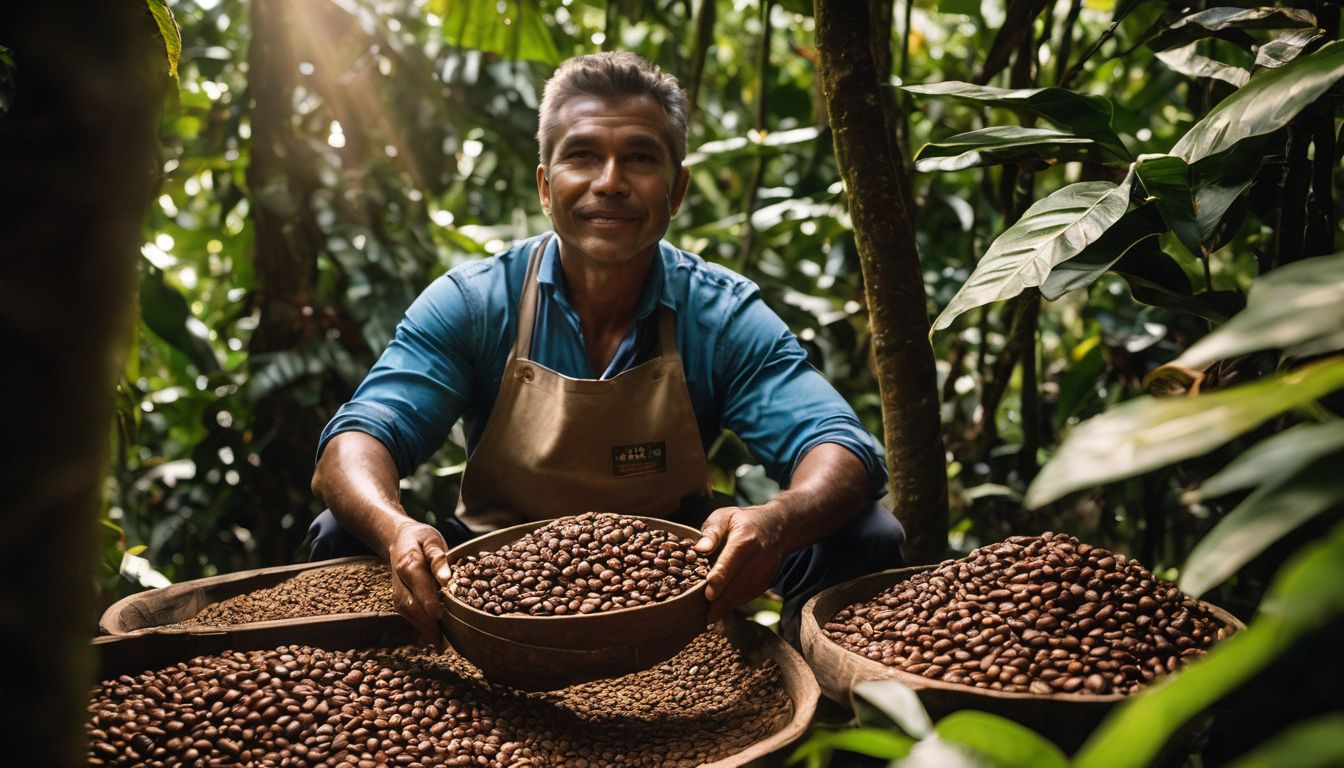As parents, it’s natural for us to fret over the unseen perils that might be hidden amidst our children’s playthings. We understand because we’ve felt that same disquietude – it’s truly disconcerting to discover just how many toys can contain harmful chemicals like lead, impacting countless young lives each year.
Our blog is brimming with vital knowledge about how choosing non-toxic toys can not only protect your little ones’ health but also foster wholesome development. Join us as we delve into a realm of secure and joyful playtimes!
Key Takeaways
- Non – toxic toys prevent exposure to harmful chemicals like cadmium, lead, phthalates, and BPA that can cause serious health problems in children.
- Opting for toys made from natural materials such as wood, organic cotton or natural rubber helps not only in safeguarding kids’ health but also supports environmental sustainability.
- Educating ourselves on the safety of toy materials and opting for certified eco – friendly options can ensure a safer play environment for children.
- Regular cleaning and proper maintenance of non – toxic toys are important to keep them safe and hygienic for children’s use.
- Being part of eco – friendly toy communities encourages sharing knowledge about sustainable playtime options and contributes to conserving our planet for future generations.
The Importance of Non-Toxic Toys for Children’s Health
Choosing non-toxic toys is crucial for children’s health, as it helps to avoid harmful chemicals and promotes a safer play environment. Additionally, opting for sustainable and eco-friendly toy options can have a positive impact on both the child’s well-being and the environment.
Avoiding harmful chemicals
We steer clear of toys laced with dangerous chemicals because they pose serious risks to our children’s health. From skin irritations to more severe issues like lead poisoning and reproductive problems, the consequences are too significant to ignore.
By opting for nontoxic playthings, we protect not only our little ones but also contribute to a healthier environment.
Seeking out safe toys for children means checking labels and familiarising ourselves with materials that won’t harm them or the planet. We look for items free from phthalates, BPA and other toxins commonly found in plastic playthings.
Investing in these alternatives offers peace of mind and upholds our commitment to preserving both child wellbeing and environmental health. Next, let’s explore precisely what substances we should avoid when choosing playtime treasures for our youngsters.
Choosing sustainable and eco-friendly options
When choosing sustainable and eco-friendly options for children’s toys, it is important to consider materials that are non-toxic and safe for the environment. Opting for toys made from natural materials such as wood, organic cotton, bamboo, or natural rubber can significantly reduce the carbon footprint and minimise exposure to harmful chemicals.
By choosing sustainable options like wooden toys or recycled plastic toys, we can promote a healthier lifestyle for our children while also contributing to a more environmentally friendly future.
Furthermore, selecting eco-friendly toy options not only benefits our children’s health but also supports conservation efforts. By opting for non-toxic and sustainably-produced toys, we can actively contribute to preserving the planet for future generations.
Let’s make informed choices by considering the environmental impact of the materials used in manufacturing children’s toys.
What Chemicals to Avoid in Children’s Toys
When it comes to choosing non-toxic toys for children, it’s important to be aware of the harmful chemicals that can be found in some toys. Substances like cadmium, lead, phthalates, and BPA are known to have adverse effects on children’s health and should be avoided at all costs.
Cadmium
Cadmium, a toxic metal found in some toys, can pose serious health risks to children if ingested or inhaled. Exposure to cadmium through toys with paint or plastic components can lead to adverse effects on a child’s bone and kidney health.
Therefore, it is crucial for environmentally conscious individuals to be vigilant about choosing non-toxic toys free from cadmium and other harmful substances. By opting for natural rubber toys, wooden toys, or eco-friendly materials instead of plastic ones containing cadmium, we can significantly reduce the risk of exposure and protect both children’s health and the environment.
Moving forward to “Lead,” another important substance to avoid in children’s toys, we’ll explore its potential impact on children’s health as well as ways to minimise exposure.
Lead
Children’s toys should be free from harmful substances like lead. Exposure to lead can have serious health effects on children, including developmental delays and learning difficulties.
To ensure the safety of children, it is important to choose non-toxic toys that are certified as lead-free. By opting for lead-free toys, we contribute to the well-being and healthy development of our children.
Choosing non-toxic toys free from lead not only protects our children’s health but also supports eco-friendly practices. We must advocate for safer play materials and actively seek out alternatives to plastic toys containing harmful substances such as lead.
Phthalates
Phthalates are chemicals commonly found in plastic toys and other children’s products. These substances are known to disrupt hormone function, potentially leading to developmental issues in children.
To protect our kids from these harmful effects, it’s crucial to opt for non-toxic toys that are phthalate-free. By choosing natural rubber or wooden toys instead of plastic ones, we can significantly reduce the risk of exposing our little ones to these hazardous chemicals.
Prioritising phthalate-free options ensures that our children can enjoy their playtime without compromising their health and wellbeing.
BPA
BPA, also known as bisphenol A, is a chemical found in many plastics and can linings. It has been linked to various health issues, including hormonal imbalances and developmental problems in children.
When choosing non-toxic toys for children, it’s crucial to opt for BPA-free options to reduce their exposure to this harmful chemical. Look for toys made from natural materials like wood, organic cotton, or natural rubber instead of plastic ones containing BPA.
Considering the potential impact on our children’s wellbeing, it’s important for us all to educate ourselves on the risks associated with chemicals like BPA in toys.
Benefits of Non-Toxic Toys for Children
Non-toxic toys promote better skin health, encourage creative play and reduce the risk of injury. Discover more about how non-toxic toys impact children’s health by reading on.
Better skin health
Non-toxic toys promote better skin health in children. They are free from harmful chemicals like lead, phthalates, and BPA, which can cause skin irritations and allergies. By choosing natural rubber or organic plush toys, parents can reduce the risk of exposing their children to skin-harming substances commonly found in traditional plastic toys.
Additionally, opting for non-toxic toys ensures that kids interact with safe materials that won’t leach harmful toxins onto their skin during playtime.
Choosing non-toxic toys also supports overall well-being by reducing the risk of skin conditions caused by exposure to toxic substances found in some conventional toys.
Lower carbon footprint
Non-toxic toys contribute to a lower carbon footprint as they are often made from sustainable and eco-friendly materials. By choosing natural rubber, wooden, or recycled plastic toys, we reduce the demand for non-renewable resources and minimise the environmental impact of production.
This conscious choice contributes to a healthier planet for future generations and aligns with our commitment to environmental conservation.
Opting for non-toxic toys not only safeguards children’s health but also promotes sustainability by decreasing our reliance on harmful manufacturing processes. We can actively participate in protecting the environment by embracing these eco-friendly play options that prioritise both child safety and environmental well-being.
Avoiding lead poisoning
To protect our children from lead poisoning, it’s crucial to opt for non-toxic toys. We need to steer clear of toys containing lead, which can have harmful effects on a child’s health.
By selecting playthings made from safe materials like wood, natural rubber, or organic fabrics, we can reduce the risk of lead exposure and help ensure healthy play options for our kids.
Choosing non-toxic toys goes a long way in safeguarding our little ones’ wellbeing and encouraging their healthy development. It empowers us as responsible parents to make informed choices about the products we bring into our homes while promoting a safer environment for our children to thrive in.
Encouraging creative play
To develop a child’s creativity, non-toxic toys offer a wide range of options. Wooden building blocks and puzzles can spark imaginative thinking and problem-solving skills. Organic plush toys encourage role play and storytelling, while Montessori-inspired toys promote independent exploration and learning.
DIY kits enable children to express their unique ideas, fostering innovation and resourcefulness. By choosing natural rubber or bamboo toys, we provide safe play materials that inspire open-ended play and imaginative scenarios.
Furthermore, recycled plastic toys can be repurposed into new creations through creative recycling projects at home. Nurturing creativity through non-toxic toy choices not only benefits the child’s development but also supports a sustainable approach to playtime activities.
Reducing the risk of injury
When selecting non-toxic toys for children, we consider the reduction of injury risk as a top priority. Wooden or soft plush toys eliminate the threat of cuts and bruises that harder plastic alternatives may cause.
Additionally, non-toxic materials like natural rubber and bamboo are less likely to break into sharp pieces, making playtime safer for children.
By choosing eco-friendly and non-toxic toys, we minimise the potential harm caused by harmful chemicals in conventional options. This approach ensures that kids can enjoy safe play without the risk of injury or exposure to toxic substances found in some traditional toys.
Types of Non-Toxic Toys for Children
From wooden toys to Montessori-inspired and natural rubber options, there are plenty of safe and eco-friendly playthings for children. To learn more about the impact of non-toxic toys on children’s health, continue reading our blog.
Wooden toys
Wooden toys offer a safe and eco-friendly play option for children, free from harmful chemicals often found in plastic toys. These timeless playthings encourage imaginative and open-ended play, promoting creativity and cognitive development.
Additionally, wooden toys are durable and sustainable, reducing the environmental impact caused by disposable plastic toys. Opting for wooden toys supports a healthier play environment for children while also contributing to conservation efforts.
Moreover, choosing wooden toys aligns with our values of sustainability and environmental responsibility. By opting for these non-toxic alternatives, we can create a safer world for our children while reducing the negative impact on our planet’s health.
Organic plush toys
Choosing organic plush toys for children is a sustainable and eco-friendly option that promotes a safer play environment. These toys are made from natural materials, free from harmful chemicals such as lead, phthalates, BPA, and other toxic substances found in conventional plush toys.
By opting for organic plush toys, we reduce the risk of exposing our children to these harmful chemicals while also supporting environmentally friendly production practices.
Organic plush toys not only benefit the health of our children but also contribute to lowering our carbon footprint. When compared to traditional plastic-based or synthetic plush toys, organic options are biodegradable or made from renewable resources like organic cotton or wool.
Montessori-inspired toys
Montessori-inspired toys foster hands-on learning and creativity in children, promoting independent thinking and problem-solving skills. These toys, often made of sustainable materials like wood or natural fibres, align with environmentally conscious values.
They encourage imaginative play while fostering a connection to the natural world.
Parents can opt for Montessori-inspired toys as an eco-friendly alternative that supports their child’s intellectual and environmental development. By selecting these toys, you introduce your child to safe and non-toxic play options that contribute positively to their health and well-being.
Bamboo toys
Bamboo toys offer a sustainable and eco-friendly play option for children. These toys are made from natural bamboo, providing a safe and non-toxic alternative to plastic or synthetic materials.
Bamboo is also biodegradable, making it an environmentally conscious choice for parents who want to reduce their carbon footprint.
The use of bamboo in toy production promotes the conservation of forests and reduces the demand for plastic products that harm ecosystems. Additionally, bamboo toys often have a unique texture that can stimulate sensory development in children, encouraging creativity and imagination during playtime.
Natural rubber toys
Natural rubber toys offer a safe and eco-friendly play option for children, free from harmful chemicals such as BPA, lead, and phthalates. These toys are sustainable and biodegradable, making them an ideal choice for environmentally conscious individuals seeking non-toxic playthings for their kids.
Furthermore, natural rubber toys encourage creative play while reducing the risk of skin irritation or allergies due to their hypoallergenic properties. By opting for natural rubber toys, parents can promote a healthier environment for their children while supporting conservation efforts.
Choosing natural rubber toys also contributes to lowering the carbon footprint associated with plastic toy production. With their durability and non-toxic nature, these toys provide an excellent alternative to conventional plastic options that may contain hazardous substances like PVC or cadmium.
DIY kits
We can also consider DIY kits as a fun and sustainable option for non-toxic toys. Engaging in do-it-yourself projects allows us to control the materials used, ensuring that they are safe and eco-friendly for our children.
By making our own toys, we reduce reliance on mass-produced plastic items and can incorporate natural materials such as wood, organic fabrics, or recycled materials, promoting creativity and environmental consciousness.
Creating DIY toys fosters a sense of accomplishment and teaches children about sustainability while providing them with safe playthings. We encourage parents to explore various DIY toy ideas like wooden puzzles, cloth dolls, upcycled cardboard playsets, or sensory bins using natural elements.
Recycled plastic toys
When considering non-toxic toy options for children, recycled plastic toys can be a sustainable choice. These toys are made from post-consumer plastics, reducing the amount of waste that ends up in landfills and oceans.
By choosing recycled plastic toys, we support the principle of recycling and help to reduce our environmental impact.
Additionally, opting for recycled plastic toys promotes awareness about the importance of repurposing materials and contributes to a circular economy. Choosing these eco-friendly playthings not only provides children with safe and enjoyable toys but also sets a positive example for sustainable living.
How to Make Playtime Safer with Non-Toxic Toys
Educate yourself on safe toy options, properly clean and care for toys, and join eco-friendly toy communities for a safer playtime experience.
Educating yourself on safe toy options
When looking to educate yourself on safe toy options, it is essential to research and understand the materials used in different toys. Check for labels indicating non-toxic, BPA-free, phthalate-free, and lead-free materials.
Look for certifications from trusted environmental organisations that confirm the safety of the toys. Additionally, consider seeking advice from eco-friendly parenting groups or forums to learn about the experiences and recommendations of others who share your environmentally conscious mindset.
By staying informed about safe toy options, you can make more sustainable choices that not only benefit your child’s health but also contribute positively to the environment. Consider regularly reviewing reliable sources of information on non-toxic toys to stay updated with any new developments or products in this space as part of your commitment towards promoting children’s environmental health.
Properly cleaning and caring for toys
After educating yourself on safe toy options, it is essential to understand the importance of properly cleaning and caring for toys. Regularly clean toys using mild soap and water, especially after outdoor play or when they have been in contact with food.
For plush toys, follow the manufacturer’s instructions for washing to avoid damaging them. Wooden toys can be wiped with a damp cloth and left to air dry thoroughly.
Toys that are made of natural rubber should be washed carefully and not submerged in water for long periods. Ensure that all parts of the toy are completely dry before allowing children to play with them again.
Joining eco-friendly toy communities
We can connect with like-minded individuals by joining eco-friendly toy communities. These communities provide a platform to share information, tips, and recommendations on sustainable and non-toxic play options for kids.
By engaging in these communities, we can stay updated on the latest eco-friendly toy trends and contribute to creating a safer and healthier environment for our children.
Taking part in eco-friendly toy communities allows us to exchange ideas with others who are passionate about supporting conservation efforts and promoting healthy playtime choices for children.
Conclusion
In conclusion, non-toxic toys are crucial for children’s health. Avoiding harmful chemicals like lead and phthalates can prevent serious health issues. Choosing natural, eco-friendly toys can promote both physical and environmental well-being.
Making informed choices about the toys we give our children is a simple yet impactful way to support their healthy development.
FAQs
1. Why are non-toxic toys important for children’s health?
Non-toxic toys safeguard children’s safety by eliminating the risks associated with harmful chemicals like lead and cadmium, which can impact child development negatively.
2. What makes silicone toys a healthy play option for kids?
Silicone toys are favoured as healthy play options because they don’t contain PVC or other potentially hazardous substances that might pose safety concerns.
3. Can natural rubber toys benefit my child?
Absolutely! Natural rubber toys offer benefits as they’re free from toxic chemicals, ensuring your child enjoys non-harmful toys during their crucial growth stages.
4. Are there environmental benefits to choosing non-toxic playthings for babies?
Yes indeed, opting for non-toxic playthings lessens the environmental impact of plastic toys and promotes a healthier planet for everyone.
5. How do I choose safe beach toys for my kids?
When selecting beach toys, always look for labels that confirm toy safety such as being free from PVC and containing no toxic materials to ensure your child has safe and fun experiences in the sand.





